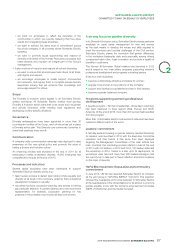APC 2015 Annual Report Download - page 97
Download and view the complete annual report
Please find page 97 of the 2015 APC annual report below. You can navigate through the pages in the report by either clicking on the pages listed below, or by using the keyword search tool below to find specific information within the annual report.
2015 REGISTRATION DOCUMENT SCHNEIDER ELECTRIC 95
SUSTAINABLE DEVELOPMENT
2
SCHNEIDER ELECTRIC, AN ECO-CITIZEN COMPANY
The project targets entrepreneurs and project owners who do
not have access to bank loans, notably the unemployed and low-
income individuals. Schneider Electric and Schneider Initiatives
Entrepreneurs, an association that nurtures spin-offs, fi nance part
of the microloans granted to electrical businesses through ADIE.
In 2015, SEEA helped refi nance 120 loans. Schneider Electric’s
French Sales Division has also created a pact with dedicated
technical training resources combined with support from a local
sales representative to help these entrepreneurs.
International investments
One transaction was concluded as part of the SEEA international
portfolio in2014:
•SunFunder is an innovative fi nancing company specializing in
companies seeking to increase energy access in sub-Saharan
Africa and emerging countries. It has a range of unique and
diverse funding offers through an online platform for participatory
fi nancing and debt funds for institutional investors. It has
recognized expertise in monitoring and selecting projects based
on a rigorous selection process and measurement of the social
impact through an online platform.
This was an investment of EUR1,900,000 as part of the SEEA
international portfolio, or about 80% of the allocation. SEEA is not
planning any further investment in this portfolio but will continue to
support the development of the companies in the portfolio.
This international investment follows up on transactions carried out
since2011:
•Kayer SARL, a Senegalese company involved in the distribution
of solar systems in rural areas. Its offering includes solar homes
systems (SHS) as well as collective systems for supplying
irrigation pumps or agricultural windmills;
•Simpa Networks, a company based in Bangalore (India)
whose business is to make individual solar systems available
to underprivileged people through a specifi cally developed
prepayment system. Simpa relies on a network of partners such
as Selco to distribute the systems;
•One Degree Solar, a company that designs and distributes small,
inexpensive solar systems in Kenya. These systems enable users
to benefi t from lighting and to recharge their cell phones;
•Fenix International, a company that designs and distributes solar
systems in Uganda, enabling users to develop a cell phone
charging business. This company has established distribution
agreements with mobile operators and has developed a
prepayment offering;
•Lumos International, a company that designs and distributes
medium-power solar systems intended to provide users with
enough energy to power household appliances such as fans
or televisions. These systems are intended to be distributed by
mobile operators. The shareholding in this company was sold to
its majority shareholder during 2015.
Offerings and business models
Approach
Innovation for Schneider Electric starts with the local needs and the
socio-economic context of those with little or no access to clean,
healthy and reliable electricity. With this in mind, the chief aims of its
offerings and business models are to:
•respond to the energy needs of villages to support sustainable
economic and social activity;
•include and involve local populations in projects to guarantee
their sustainability in the long term.
Schneider Electric sets out to provide comprehensive energy access
solutions that support revenue-generating entrepreneurial activities,
foster community services or fulfi ll domestic needs. Products and
solutions are developed to meet a range of both individual and
community needs across the energy chain, from portable lamps
and solar home systems to decentralized small power plants, water
pumping systems and street lighting.
Action plans
Offer a wide range of services for all energy access
needs
Individual lighting: In a program to extend access to energy,
lighting is one of the fi rst vital needs expressed by population groups
denied access or reliable access to the electricity grid. Lighting
makes it possible to study after the sun has gone down and to
extend entrepreneurial activities into the evening. In 2013, Mobiya
TS120S was launched, a portable solar light-emitting diode (LED)
lamp that is both robust and affordable and offers up to 48 hours
of lighting without recharging as well as offering a charging solution
for cell phones. Its shape and ergonomic grip allows you to position
the lamp in seven different ways to adapt to various situations in
daily life: practical activities such as lighting a room or a targeted
area, marking a route, cooking, sewing, reading and charging a cell
phone. Its original design has already won three awards.
Individual electrification: Solar Home Systems (SHS) guarantee
domestic households and small entrepreneurs’ access to electricity
for their day-to-day and income-generating activities. The central
component of SHS is the solar charge controller for connecting
photovoltaic cells and batteries for powering small direct-current
devices such as fans, radios or televisions, as well as low-
consumption LED lamps and cell phones. In 2014, the Access to
Energy program extended its offering to provide Homaya MS, a
range of SHS dedicated to individual income-generating activities
which use higher-power alternating-current equipment (miller, tailor,
hairdresser, restaurant, grocery, cinema, etc.).
























